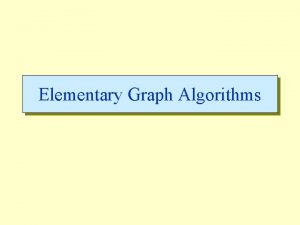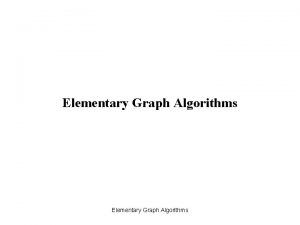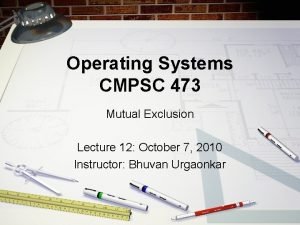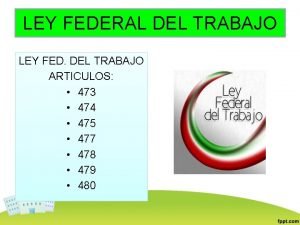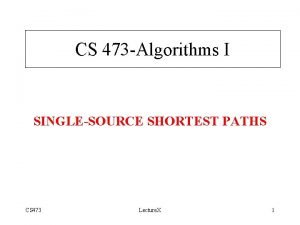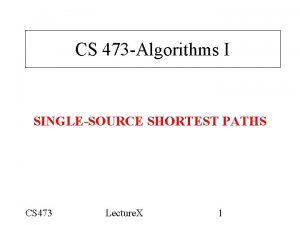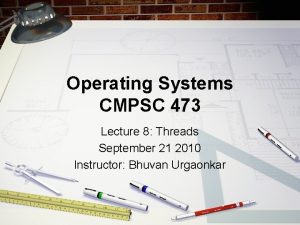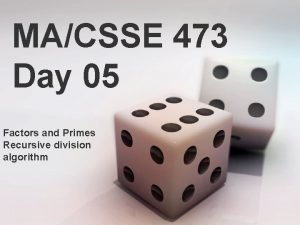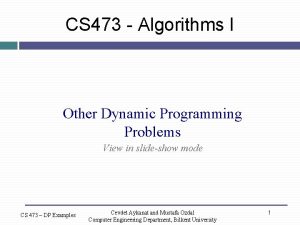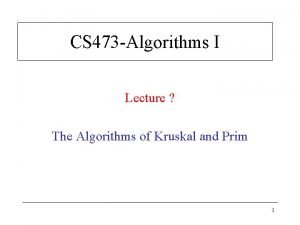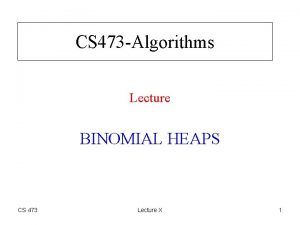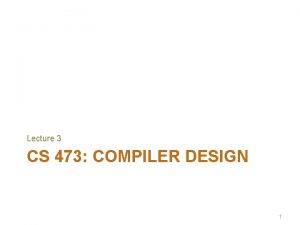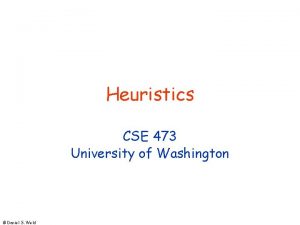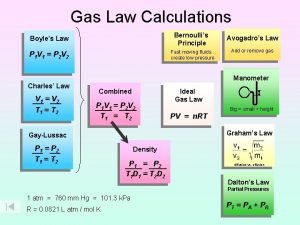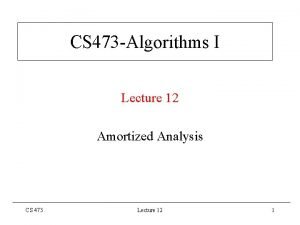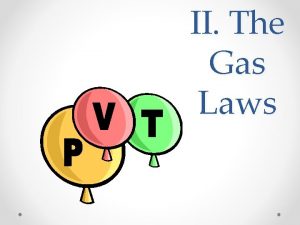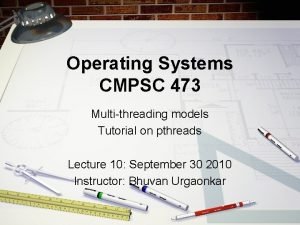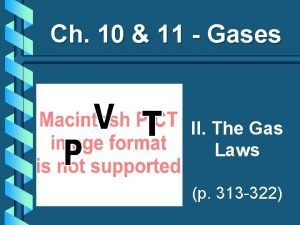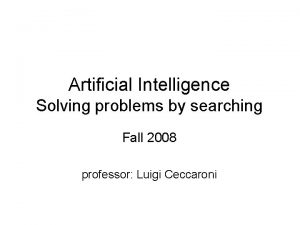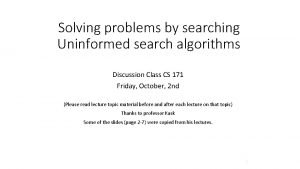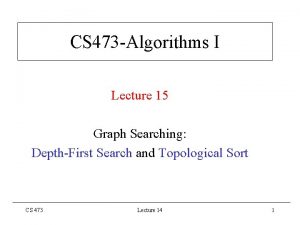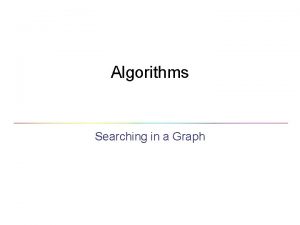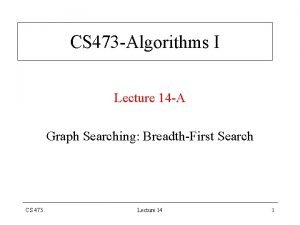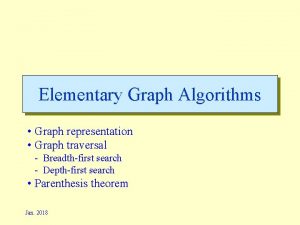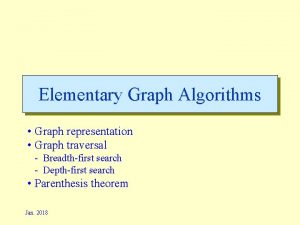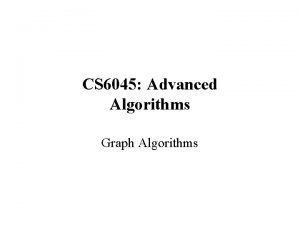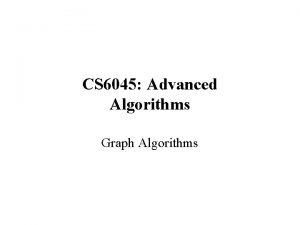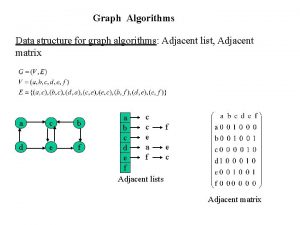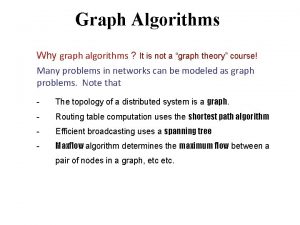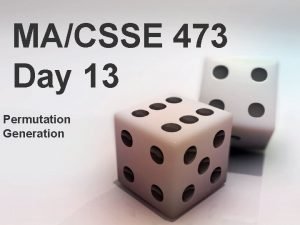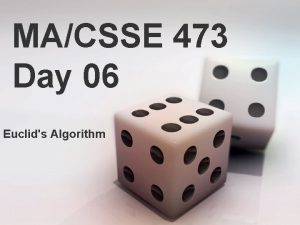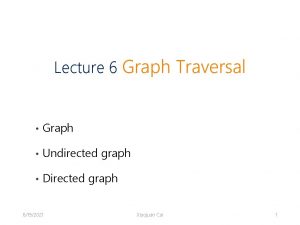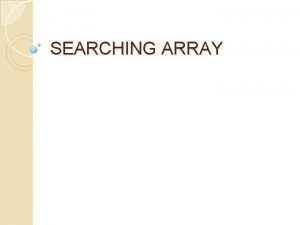CS 473 Algorithms I Lecture 15 Graph Searching

![DFS: Parenthesis Theorem Thm: In any DFS of G (V, E), let int[v] [d[v], DFS: Parenthesis Theorem Thm: In any DFS of G (V, E), let int[v] [d[v],](https://slidetodoc.com/presentation_image/4bc16304e36a182d1eaa0569aea1c25f/image-2.jpg)
![Parenthesis Thm (proof for the case d[u] d[v]) Subcase d[v] f[u] (int[u] and int[v] Parenthesis Thm (proof for the case d[u] d[v]) Subcase d[v] f[u] (int[u] and int[v]](https://slidetodoc.com/presentation_image/4bc16304e36a182d1eaa0569aea1c25f/image-3.jpg)







































![Topological Sort of a DAG Correctness of the Algorithm Claim: (u, v) E f[u] Topological Sort of a DAG Correctness of the Algorithm Claim: (u, v) E f[u]](https://slidetodoc.com/presentation_image/4bc16304e36a182d1eaa0569aea1c25f/image-43.jpg)
- Slides: 43

CS 473 -Algorithms I Lecture 15 Graph Searching: Depth-First Search and Topological Sort CS 473 Lecture 15 1
![DFS Parenthesis Theorem Thm In any DFS of G V E let intv dv DFS: Parenthesis Theorem Thm: In any DFS of G (V, E), let int[v] [d[v],](https://slidetodoc.com/presentation_image/4bc16304e36a182d1eaa0569aea1c25f/image-2.jpg)
DFS: Parenthesis Theorem Thm: In any DFS of G (V, E), let int[v] [d[v], f[v]] then exactly one of the following holds for any u and v V • int[u] and int[v] are entirely disjoint • int[v] is entirely contained in int[u] and v is a descendant of u in a DFT • int[u] is entirely contained in int[v] and u is a descendant of v in a DFT CS 473 Lecture 15 2
![Parenthesis Thm proof for the case du dv Subcase dv fu intu and intv Parenthesis Thm (proof for the case d[u] d[v]) Subcase d[v] f[u] (int[u] and int[v]](https://slidetodoc.com/presentation_image/4bc16304e36a182d1eaa0569aea1c25f/image-3.jpg)
Parenthesis Thm (proof for the case d[u] d[v]) Subcase d[v] f[u] (int[u] and int[v] are overlapping) – v was discovered while u was still GRAY – This implies that v is a descendant of u – So search returns back to u and finishes u after finishing v – i. e. , d[v] f[u] int[v] is entirely contained in int[u] Subcase d[v] f[u] int[v] and int[u] are entirely disjoint Proof for the case d[v] d[u] is similar (dual) QED CS 473 Lecture 15 3

Nesting of Descendents’ Intervals Corollary 1 (Nesting of Descendents’ Intervals): v is a descendant of u if and only if d[u] d[v] f[u] Proof: immediate from the Parenthesis Thrm QED CS 473 Lecture 15 4

Parenthesis Theorem CS 473 Lecture 15 5

Edge Classification in a DFF Tree Edge: discover a new (WHITE) vertex GRAY to WHITE Back Edge: from a descendent to an ancestor in DFT GRAY to GRAY Forward Edge: from ancestor to descendent in DFT GRAY to BLACK Cross Edge: remaining edges (btwn trees and subtrees) GRAY to BLACK Note: ancestor/descendent is wrt Tree Edges CS 473 Lecture 15 6

Edge Classification in a DFF • How to decide which GRAY to BLACK edges are forward, which are cross Let BLACK vertex v Adj[u] is encountered while processing GRAY vertex u – (u, v) is a forward edge if d[u] d[v] – (u, v) is a cross edge if d[u] d[v] CS 473 Lecture 15 7

Depth-First Search: Example CS 473 Lecture 15 8

Depth-First Search: Example CS 473 Lecture 15 9

Depth-First Search: Example CS 473 Lecture 15 10

Depth-First Search: Example CS 473 Lecture 15 11

Depth-First Search: Example CS 473 Lecture 15 12

Depth-First Search: Example CS 473 Lecture 15 13

Depth-First Search: Example CS 473 Lecture 15 14

Depth-First Search: Example CS 473 Lecture 15 15

Depth-First Search: Example CS 473 Lecture 15 16

Depth-First Search: Example CS 473 Lecture 15 17

Depth-First Search: Example CS 473 Lecture 15 18

Depth-First Search: Example CS 473 Lecture 15 19

Depth-First Search: Example CS 473 Lecture 15 20

Depth-First Search: Example CS 473 Lecture 15 21

Depth-First Search: Example CS 473 Lecture 15 22

Depth-First Search: Example CS 473 Lecture 15 23

Depth-First Search: Example CS 473 Lecture 15 24

Depth-First Search: Example CS 473 Lecture 15 25

Depth-First Search: Example CS 473 Lecture 15 26

Depth-First Search: Example CS 473 Lecture 15 27

Depth-First Search: Example CS 473 Lecture 15 28

Depth-First Search: Example CS 473 Lecture 15 29

DFS on Undirected Graphs • Ambiguity in edge classification, since (u, v) and (v, u) are the same edge – First classification is valid (whichever of (u, v) or (v, u) is explored first) Lemma 1: any DFS on an undirected graph produces only Tree and Back edges CS 473 Lecture 15 30

Lemma 1: Proof Assume (u, v) is a C (C? ) btw subtrees Assume (x, z) is a F (F? ) But (x, z) must be a B, since DFS must finish z before resuming x CS 473 But (y, u) & (y, v) cannot be both T; one must be a B and (u, v) must be a T If (u, v) is first explored while processing u/v, (y, v) / (y, u) must be a B Lecture 15 31

DFS on Undirected Graphs Lemma 2: an undirected graph is acyclic (i. e. a forest) iff DFS yields no Back edges Proof (acyclic no Back edges; by contradiction): Let (u, v) be a B then color[u] color[v] GRAY there exists a path between u and v So, (u, v) will complete a cycle (Back edge cycle) (no Back edges acyclic): If there are no Back edges then there are only T edges by Lemma 1 forest acyclic QED CS 473 Lecture 15 32

DFS on Undirected Graphs How to determine whether an undirected graph G (V, E) is acyclic • Run a DFS on G: if a Back edge is found then there is a cycle • Running time: O(V), not O(V E) – If ever seen |V| distinct edges, must have seen a back edge (|E| |V| 1 in a forest) CS 473 Lecture 15 33

DFS: White Path Theorem WPT: In a DFS of G, v is a descendent of u iff at time d[u], v can be reached from u along a WHITE path Proof ( ): assume v is a descendent of u Let w be any vertex on the path from u to v in the DFT So, w is a descendent of u d[u] d[w] (by Corollary 1 nesting of descendents’ intervals) Hence, w is white at time d[u] CS 473 Lecture 15 34

DFS: White Path Theorem Proof ( ) assume a white path p(u, v) at time d[u] but v does not become a descendent of u in the DFT (contradiction): Assume every other vertex along p becomes a descendent of u in the DFT at time d[u] p(u, v) CS 473 Lecture 15 35

DFS: White Path Theorem otherwise let v be the closest vertex to u along p that does not become a descendent Let w be predecessor of v along p(u, v): (1) d[u] d[w] f[u] by Corollary 1 (2) Since, v was WHITE at time d[u] (u was GRAY) d[u] d[v] Since, w is a descendent of u but v is not d[w] d[v] f[w] (3) By (1)–(3): d[u] d[v] f[w] f[u] d[v] f[w] So by Parenthesis Thm int[v] is within int[u], v is QED descendent of u CS 473 Lecture 15 36

Directed Acyclic Graphs (DAG) No directed cycles Example: CS 473 Lecture 15 37

Directed Acyclic Graphs (DAG) Theorem: a directed graph G is acyclic iff DFS on G yields no Back edges Proof (acyclic no Back edges; by contradiction): Let (v, u) be a Back edge visited during scanning Adj[v] color[u] GRAY and d[u] d[v] int[v] is contained in int[u] v is descendent of u a path from u to v in a DFT and hence in G edge (v, u) will create a cycle (Back edge cycle) u CS 473 v path from u to v in a DFT and hence in G Lecture 15 38

acyclic iff no Back edges Proof (no Back edges acyclic): Suppose G contains a cycle C (Show that a DFS on G yields a Back edge; proof by contradiction) Let v be the first vertex discovered in C and let (u, v) be proceeding edge in C At time d[v]: a white path from v to u along C By White Path Thrm u becomes a descendent of v in a DFT Therefore (u, v) is a Back edge (descendent to ancestor) CS 473 Lecture 15 39

Topological Sort of a DAG • Linear ordering ‘ ’ of V such that (u, v) E u v in ordering – Ordering may not be unique – i. e. , mapping the partial ordering to total ordering may yield more than one orderings CS 473 Lecture 15 40

Topological Sort of a DAG Example: Getting dressed CS 473 Lecture 15 41

Topological Sort of a DAG Algorithm run DFS(G) when a vertex finished, output it vertices output in reverse topologically sorted order Runs in O(V+E) time CS 473 Lecture 15 42
![Topological Sort of a DAG Correctness of the Algorithm Claim u v E fu Topological Sort of a DAG Correctness of the Algorithm Claim: (u, v) E f[u]](https://slidetodoc.com/presentation_image/4bc16304e36a182d1eaa0569aea1c25f/image-43.jpg)
Topological Sort of a DAG Correctness of the Algorithm Claim: (u, v) E f[u] f[v] Proof: consider any edge (u, v) explored by DFS when (u, v) is explored, u is GRAY – if v is GRAY, (u, v) is a Back edge (contradicting acyclic theorem) – if v is WHITE, v becomes a descendent of u (b WPT) f[v] f[u] – if v is BLACK, f[v] d[u] f[v] f[u] QED CS 473 Lecture 15 43
 Ocr gcse computer science algorithm questions
Ocr gcse computer science algorithm questions Introduction to algorithms lecture notes
Introduction to algorithms lecture notes Analysis of algorithms lecture notes
Analysis of algorithms lecture notes 01:640:244 lecture notes - lecture 15: plat, idah, farad
01:640:244 lecture notes - lecture 15: plat, idah, farad Elementary graph algorithms
Elementary graph algorithms Undirected graph algorithms
Undirected graph algorithms Topological sort演算法
Topological sort演算法 When graphs are life
When graphs are life Graph neural network lecture
Graph neural network lecture Characteristics of gases
Characteristics of gases Cmpsc 473
Cmpsc 473 Articulo 474
Articulo 474 Eecs 473
Eecs 473 Cs 473
Cs 473 Eecs473
Eecs473 Cs 473
Cs 473 Nuvw
Nuvw 27 rounds to 20
27 rounds to 20 Cmpsc 473
Cmpsc 473 Factors of 473
Factors of 473 A gas occupies 473 cm3 at 36°c. find its volume at 94°c
A gas occupies 473 cm3 at 36°c. find its volume at 94°c Bilkent cs473
Bilkent cs473 Kruskal algorithm in c
Kruskal algorithm in c Cs 473
Cs 473 Cs 473
Cs 473 Uw cse 473
Uw cse 473 Cmpsc 473
Cmpsc 473 A gas occupies 473 cm3 at 36°c. find its volume at 94°c
A gas occupies 473 cm3 at 36°c. find its volume at 94°c Pv = k
Pv = k Cs 473
Cs 473 Cmpsc 473
Cmpsc 473 Eecs 473
Eecs 473 Cs 473
Cs 473 Boyle's law examples
Boyle's law examples Multithreading models in os
Multithreading models in os A gas occupies 473 cm3 at 36°c. find its volume at 94°c
A gas occupies 473 cm3 at 36°c. find its volume at 94°c Handshaking theorem
Handshaking theorem Resource allocation graph and wait for graph
Resource allocation graph and wait for graph Solving problems by searching artificial intelligence
Solving problems by searching artificial intelligence List the 4 nets for better internet searching.
List the 4 nets for better internet searching. A storm system moves 5000 km due east
A storm system moves 5000 km due east Picture searching
Picture searching Algorithm for sequential search
Algorithm for sequential search A bear searching for food wanders 35 meters east
A bear searching for food wanders 35 meters east




